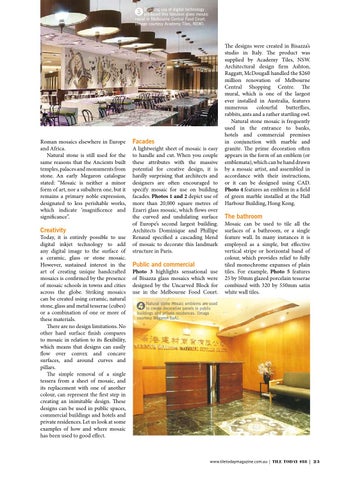Stunning use of digital technology produced this fabulous glass mosaic mural in Melbourne Central Food Court. (Image courtesy Academy Tiles, NSW).
3
Roman mosaics elsewhere in Europe and Africa. Natural stone is still used for the same reasons that the Ancients built temples, palaces and monuments from stone. An early Megaron catalogue stated: “Mosaic is neither a minor form of art, nor a subaltern one, but it remains a primary noble expression, designated to less perishable works, which indicate ‘magnificence and significance”.
Creativity Today, it is entirely possible to use digital inkjet technology to add any digital image to the surface of a ceramic, glass or stone mosaic. However, sustained interest in the art of creating unique handcrafted mosaics is confirmed by the presence of mosaic schools in towns and cities across the globe. Striking mosaics can be created using ceramic, natural stone, glass and metal tesserae (cubes) or a combination of one or more of these materials. There are no design limitations. No other hard surface finish compares to mosaic in relation to its flexibility, which means that designs can easily flow over convex and concave surfaces, and around curves and pillars. The simple removal of a single tessera from a sheet of mosaic, and its replacement with one of another colour, can represent the first step in creating an inimitable design. These designs can be used in public spaces, commercial buildings and hotels and private residences. Let us look at some examples of how and where mosaic has been used to good effect.
Facades A lightweight sheet of mosaic is easy to handle and cut. When you couple these attributes with the massive potential for creative design, it is hardly surprising that architects and designers are often encouraged to specify mosaic for use on building facades. Photos 1 and 2 depict use of more than 20,000 square metres of Ezarri glass mosaic, which flows over the curved and undulating surface of Europe’s second largest building. Architects Dominique and Phillipe Renaud specified a cascading blend of mosaic to decorate this landmark structure in Paris.
Public and commercial Photo 3 highlights sensational use of Bisazza glass mosaics which were designed by the Uncarved Block for use in the Melbourne Food Court.
The designs were created in Bisazza’s studio in Italy. The product was supplied by Academy Tiles, NSW. Architectural design firm Ashton, Raggatt, McDougall handled the $260 million renovation of Melbourne Central Shopping Centre. The mural, which is one of the largest ever installed in Australia, features numerous colourful butterflies, rabbits, ants and a rather startling owl. Natural stone mosaic is frequently used in the entrance to banks, hotels and commercial premises in conjunction with marble and granite. The prime decoration often appears in the form of an emblem (or emblemata), which can be hand drawn by a mosaic artist, and assembled in accordance with their instructions, or it can be designed using CAD. Photo 4 features an emblem in a field of green marble installed at the Hall Harbour Building, Hong Kong.
The bathroom Mosaic can be used to tile all the surfaces of a bathroom, or a single feature wall. In many instances it is employed as a simple, but effective vertical stripe or horizontal band of colour, which provides relief to fully tiled monochrome expanses of plain tiles. For example, Photo 5 features 25 by 50mm glazed porcelain tesserae combined with 320 by 550mm satin white wall tiles.
Natural stone mosaic emblems are used to create decorative panels in public buildings and private residences. (Image courtesy Megaron SpA).
4
www.tiletodaymagazine.com.au | TILE TODAY #88 | 23
